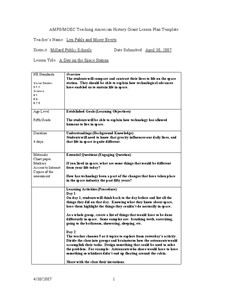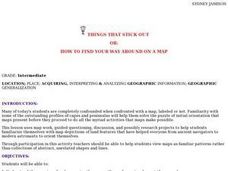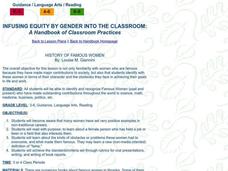Curated OER
HISTORY OF SCIENCE: ASTRONAUTS
Students study the pioneers of space exploration and travel; identify some of the early astronauts who prepared the way for others; examine the social and political conditions at the dawn of the Space Age; and differentiate among space...
Curated OER
Astronaut Diet
Middle schoolers discover foods that astronauts eat in space and eat an actual astronaut meal. In this astronaut diet lesson, students discover how food is freeze-dried and packaged for use in space. Middle schoolers compare an...
Curated OER
Moon Mining
Go on a moon mining expedition from the safety of your classroom with this space exploration simulation. Using simple models of the moon's surface prepared ahead of time by the teacher, young scientists are challenged with locating and...
Curated OER
History of Famous Women
Students discover the famous women who changed society by setting positive examples. In this equality instructional activity, students research a female person who had a positive effect on the world by fighting for her equal rights. ...
Laboratory for Atmospheric and Space Physics
Space Travel Guide
Looking to take a trip? Why not go to space? Here, scholars take on the role as travel agent to create a guide to their favorite planet including travel tips and sightseeing recommendations.
Curated OER
Men, Women, and Careers
Teach young learners that they can have any job they want, no matter their gender! An elementary lesson emphasizes that while some jobs may be more closely associated with men or with women, people of either gender can complete them....
Curated OER
Milestones in the Space Program
Middle schoolers brainstorm names of astronauts from NASA space missions. They are explained that the Cold War was not actually a war but pervasive tension that existed between the United States and the Soviet Union for several decades...
Curated OER
Destination Outer Space
Students investigate space travel. In this space travel lesson students examine space exploration history, engineers and scientists involved in space exploration, and Newton's third law of motion. Students make rockets.
Curated OER
A Tough Nut to Crack
Sixth graders explore agriculture by examining world geography. In this pecan cultivation lesson plan, 6th graders identify the history of the famous nut and the impact it has on the U.S. economy, diet and human body. Students define...
Curated OER
A Day on the Space Station
Fifth graders discover what it would be like to live in space. In this technological advancements lesson, 5th graders discuss how space life would be different from Earth life. Students also identify how technology has made life in space...
Curated OER
Things That Stick Out Or: How To Find Your Way Around on a Map
Students explain the meaning of and recognize the map outlines of a peninsula, an isthmus, and a cape.
Curated OER
NASA, Impact on Space
Students examine the work of NASA. In this space exploration lesson, students watch "1958: Project Mercury Begins." Students then view a PowerPoint presentation about the history of NASA and research each of the manned space programs.
Alabama Learning Exchange
The History of Space Exploration
Young scholars research and identify important events in the history of space exploration. They work in groups of three to four in order to research an important astronaut and record their finding on a poster board and present to the class.
Curated OER
History of Flight Timeline
Students research flight timelines and record their findings. In this flight lesson plan, students brainstorm with a KWL chart on what they want to learn about the history of flight. They then make a timeline of their findings, and...
University of Colorado
Space Travel Guide
Neptune takes 164.8 Earth years to travel around the sun. In the fifth of 22 lessons, young scientists create a travel guide to a planet in our solar system. They provide tips for others on what to bring, what they see, and their...
Curated OER
Shoot for the Moon
Second graders distinguish the different phases of the moon. In this astronomy lesson, 2nd graders study the history of its discovery and myths about its origin. They simulate how the moon's surface is illuminated by the sun.
Curated OER
once and future MOON
Beyond the phases of the moon, this comprehensive lesson plan covers geologic history and geology. Amateur astronauts examine photos of the lunar landscape, experiment with the creation of craters, and delve into information about the...
Curated OER
Masks: History and Artistry
Students research masks and their purposes,. They listen to the teacher read books about masks. Students study techniques for working with clay, they create masks from clay. Students take pictures of the process and the finished project,...
Curated OER
Lunar Real Estate
Students investigate the aspect of colonizing the moon by comparing techniques that are used on Earth. The colonization takes place with the planning of a hypothetical model. The model is used as a point of discussion and target...
Curated OER
Flying High in Ohio
Her is a lesson using the Ohio State Quarter. Pupils utilize beautifully-designed worksheets embedded in the plan, to study about the origins of aviation. Many of the pioneers of aviation were born in Ohio. They compare some of the...
Curated OER
Distinguished Discoveries: Florida quarter reverse
Florida's state quarter has an image of a space shuttle and a Spanish Galleon on its reverse side. Pupils will examine the state quarter and think about how the Spanish explorers and Space explorers are the same and different. The class...
Curated OER
History of Famous Women
Students explore famous women who have made contributions to the world.
Curated OER
Women In Space: Sally Ride
Second graders explore the life and accomplishments of Sally Ride, the first American woman in space. Through reading and discussion, they recall details from Sally Ride's life.
Curated OER
Program Your Partner
Students explore the world of robotics. In this robotics lesson, students study the history of robots and work with partners to find out how hard it is to accurately guide robots through simple tasks.

























